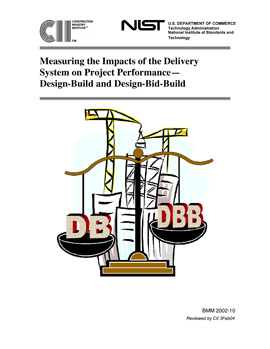
Measuring the Impacts of the Delivery System on Project Performance -- Design-Build and Design-Bid-Build
This study, sponsored by the National Institute for Standards and Technology (NIST), was designed to meet two objectives: to produce a comprehensive information set that documents the impacts of the project delivery system on project outcomes, and to provide the construction industry a means by which it may measure and evaluate the economic value of the design-build and the design-bid-build project delivery systems.
The study consisted of four tasks. The first was a statistical analysis of a broad crosssection of projects from the Construction Industry InstituteTM (CIITM) Benchmarking and Metrics (BM&M) database. The second was to tabulate key database characteristics and important findings from the Task 1 statistical analysis. Task 3 was the statistical analysis and tabulation of four subsets of projects from the CII database: by sector, industry group, cost category, and project nature. The fourth task was the preparation and delivery of this technical report, which synthesizes the findings from Tasks 1-3 of this research effort.
The analytic data set comprises all U.S. domestic and international projects submitted by owners and contractors between 1997 and 2000 using versions 2.0 through 6.0 of the CII Benchmarking and Metrics questionnaire. Using information reported on the BM&M questionnaire, both owner and contractor-submitted projects were classified as either design-build (DB) or design-bid-build (DBB) projects. The results were presented for both owner and contractors in tables that compared DB and DBB projects overall and by each of the four subsets of projects.
The results of this study show that on average DB projects were about four times larger than DBB projects in terms of project cost. Public sector projects made less use of the DB project delivery system than private sector projects. Industrial projects made greater use of DB than did building projects. Overall, owner-submitted DB projects outperformed DBB projects in cost, schedule, changes, rework, and practice use, although statistically significant differences were found only for schedule, changes, rework, and practice use. Contractor-submitted DB projects overall outperformed DBB projects in changes, rework, and practice use, but the difference was statistically significant only for change performance. Contractor-submitted DBB projects overall outperformed DB projects in schedule, and the difference was statistically significant. Pre-project planning and project change management practice use had the greatest impacts on cost performance for owner-submitted DB and DBB projects. Team building practice use had the greatest schedule performance impact on owner-submitted DB projects. Project change management and team building practice use had the greatest impacts on contractor-submitted DB project performance. Project change management occurred most frequently as the practice that had the greatest performance impact among contractor-submitted DBB projects.
- Owners – There seemed to be a performance advantage when the DB delivery system was used.
- Contractors – The performance advantage for one delivery system over the other was not as clear.
Practice use seemed to be a driver of performance results as much as project delivery system. No one project delivery system is likely to provide the best performance for all projects and for all participants.
- Cost performance was better for DB projects than it was for DBB projects.
- Projects using DB consistently demonstrated better schedule performance.
- For changes, rework, and practice use, DB projects clearly had the advantage over DBB projects
- For industrial projects, DBB projects had better safety performance.
- No difference in cost performance was observed between DB and DBB projects.
- Projects using DBB achieved better schedule performance than project using DB.
- For changes, rework, and practice use, DB projects usually outperformed DBB projects.
- Neither delivery system dominated the other in regard to safety performance.
It was generally found that projects with higher practice use scores also tended to have better performance outcomes. Some practices were more likely than others to be associated with better performance, however (BMM2002-10, p. 53).
For owners, a sample of key results includes:- The use of the DB delivery system tended to yield better performance outcomes for owner-submitted projects; these projects tended to have better performance in cost, schedule, changes, rework, and practice use.
- Pre-project planning and project change management provided the greatest benefit in cost performance.
- DBB projects outperformed DB projects in schedule, but contractor-submitted DB projects had better performance in changes, rework, and practice use.
- Pre-project planning and project change management provided the greatest benefit in cost performance.

